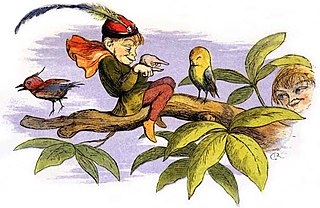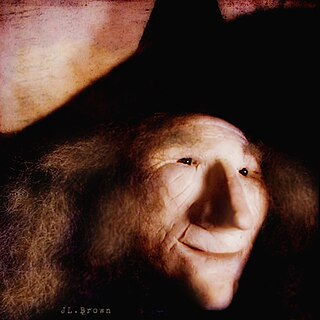Boggart is one of numerous related terms used in English folklore for either a household spirit or a malevolent genius loci inhabiting fields, marshes or other topographical features. Other names of this group include bug, bugbear, bogey, bogun, bogeyman, bogle, etc., presumably all derived from Old English pūcel, Irish púca and Welsh bwg with the same meaning.

An ogre is a legendary monster usually depicted as a large, hideous, man-like being that eats ordinary human beings, especially infants and children. Ogres frequently feature in mythology, folklore, and fiction throughout the world. They appear in many classic works of literature, and are most often associated in fairy tales and legend with a taste for infants.

In mythology, folklore and speculative fiction, shapeshifting is the ability to physically transform through an inherently superhuman ability, divine intervention, demonic manipulation, sorcery, spells or having inherited the ability. The idea of shapeshifting is in the oldest forms of totemism and shamanism, as well as the oldest extant literature and epic poems such as the Epic of Gilgamesh and the Iliad. The concept remains a common trope in conspiracy theories, modern fantasy, children's literature and popular culture.

A hobgoblin is a spirit of the hearth, typically appearing in folklore, once considered helpful but since the spread of Christianity has often been considered mischievous. Shakespeare identifies the character of Puck in his A Midsummer Night's Dream as a hobgoblin.
The púca, pooka, phouka is primarily a creature of Celtic folklore. Considered to be bringers both of good and bad fortune, they could help or hinder rural and marine communities. Púcaí can have dark or white fur or hair. The creatures were said to be shape-changers, which could take the appearance of horses, goats, cats, dogs, and hares. They may also take a human form, which includes various animal features, such as ears or a tail.

The Bogeyman is a mythical creature used by adults to frighten children into good behaviour. The Bogeyman has no specific appearance, and conceptions vary drastically by household and culture, but is commonly depicted as a masculine or androgynous monster that punishes children for misbehavior. The Bogeyman or a somewhat related creature can be found in every culture. Bogeymen may target a specific act or general misbehaviour, depending on what purpose needs serving, often based on a warning from the child's authority figure. The term "Bogeyman" is sometimes used as a non-specific personification or metonym for terror, and in some cases, the Devil.

Werewolf fiction denotes the portrayal of werewolves and other shapeshifting man/woman-beasts, in the media of literature, drama, film, games, and music. Werewolf literature includes folklore, legend, saga, fairy tales, Gothic and Horror fiction, fantasy fiction and poetry. Such stories may be supernatural, symbolic or allegorical. A classic American cinematic example of the theme is The Wolf Man (1941) and in later films joins with Frankenstein's monster and Count Dracula, as one of the three famous icons of the modern day horror. However, werewolf fiction is an exceptionally diverse genre with ancient folkloric roots and manifold modern re-interpretations.

English folklore is the folklore of England, including its legends, traditional recipes, and jokes in the regions.
In Northern English folklore, the Barghest or Barguest is a mythical monstrous black dog with large teeth and claws, though in other cases the name can refer to a ghost or household elf, especially in Northumberland and Durham, such as the Cauld Lad of Hylton.

A hellhound is a supernatural dog in folklore. A wide variety of ominous or hellish supernatural dogs occur in mythologies around the world. Features that have been attributed to hellhounds include mangled black fur, glowing red eyes, super strength and speed, ghostly or phantom characteristics, and a foul odor. Certain European legends state that if someone stares into a hellhound's eyes three times or more, that person will surely die. In cultures that associate the afterlife with fire, hellhounds may have fire-based abilities and appearance. They are often assigned to guard the entrances to the world of the dead, such as graveyards and burial grounds, or undertake other duties related to the afterlife or the supernatural, such as hunting lost souls or guarding a supernatural treasure. In European legends, seeing a hellhound or hearing it howl may be an omen or even a cause of death. They are said to be the protectors of the supernatural, guarding the secrecy of supernatural creatures, or beings, from the world.

A werecat is an analogy to "werewolf" for a feline therianthropic creature.
Jenny Greenteeth aka Wicked Jenny is a figure in English folklore. A river hag, similar to Peg Powler or a grindylow, she would pull children or the elderly into the water and drown them. The name is also used to describe pondweed or duckweed, which can form a continuous mat over the surface of a small body of water, making it misleading and potentially treacherous, especially to unwary children. With this meaning the name is common around Liverpool and southwest Lancashire.

A black dog is a motif of a spectral or demonic entity found primarily in the folklore of the British Isles. The black dog is essentially a nocturnal apparition, in some cases a shapeshifter, and is often said to be associated with the Devil or described as a ghost or hellhound. Its appearance was regarded as a portent of death. It is generally supposed to be larger than a normal dog and often has large glowing eyes. It is sometimes associated with electrical storms and also with crossroads, places of execution and ancient pathways.
Sources and influences on the development of Dungeons & Dragons include fantasy fiction, mythology, and wargaming rules, among others.
Maggy Moulach is a character from Scottish folklore and mythology said to be a Highland Brownie. According to the folklore, she had a son named Brownie-Clod, who was said to be a Dobie. A Dobie is a somewhat dull-witted, though well-intentioned, variety of brownie.
Mythic humanoids are mythological creatures that are part human or resemble humans through appearance or character.

In mythology, and in the study of folklore and religion, a trickster is a character in a story, which exhibits a great degree of intellect or secret knowledge, and uses it to play tricks or otherwise disobey normal rules and conventional behaviour.

A hag is a wizened old woman, or a kind of fairy or goddess having the appearance of such a woman, often found in folklore and children's tales such as Hansel and Gretel. Hags are often seen as malevolent, but may also be one of the chosen forms of shapeshifting deities, such as the Morrígan or Badb, who are seen as neither wholly benevolent nor malevolent.
The British legend of the ghostly black dog has appeared many times in popular culture.